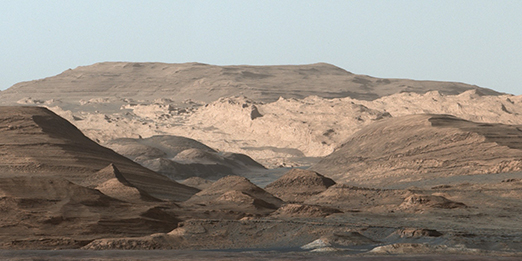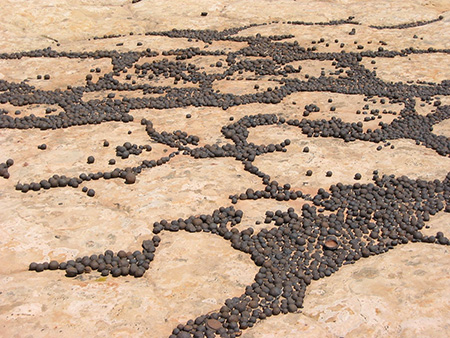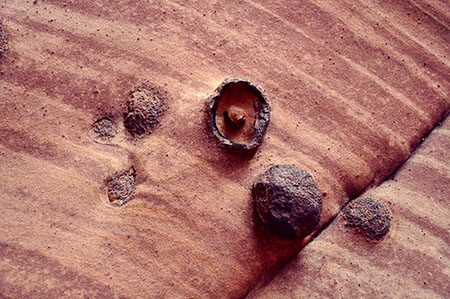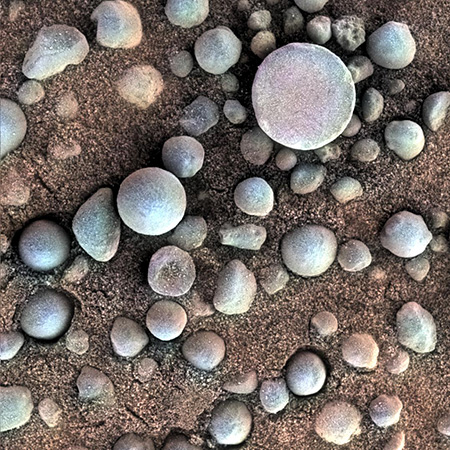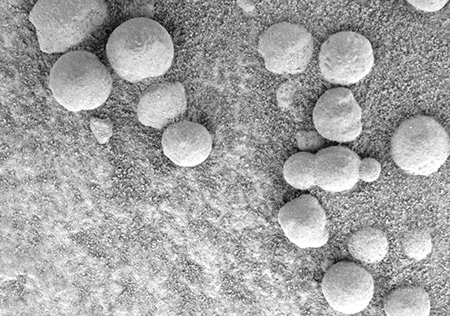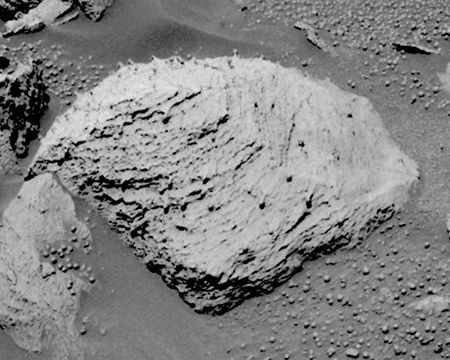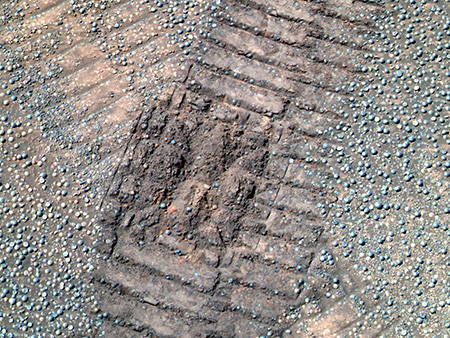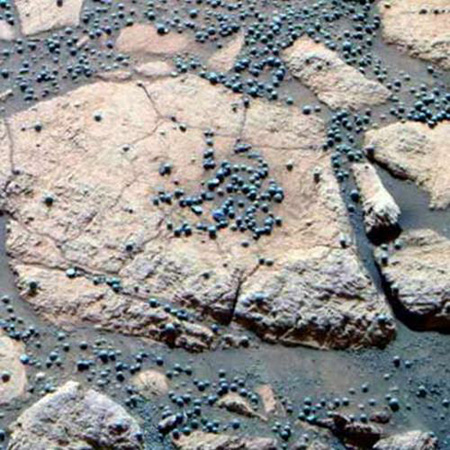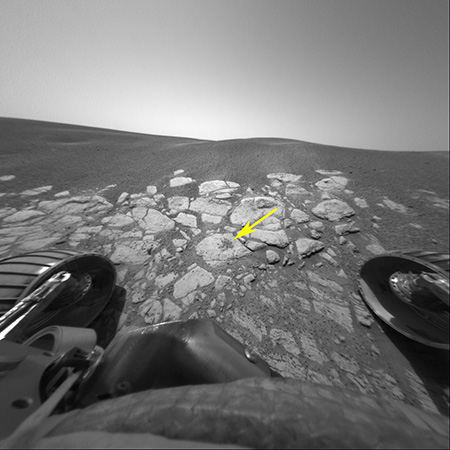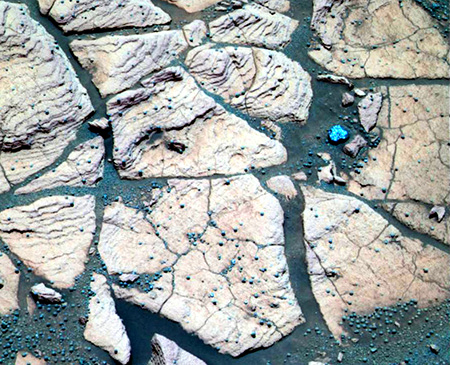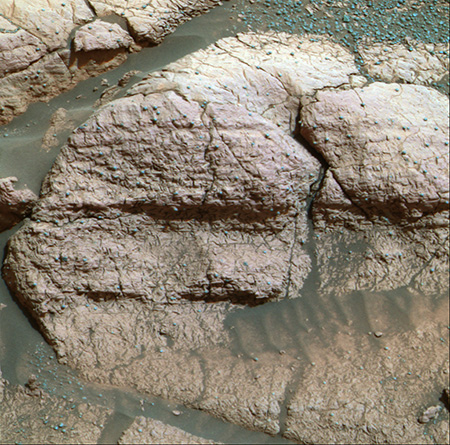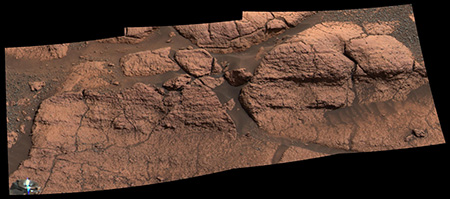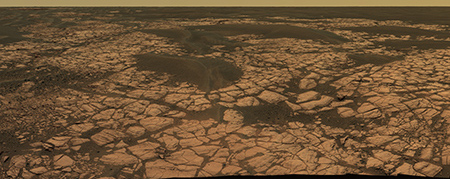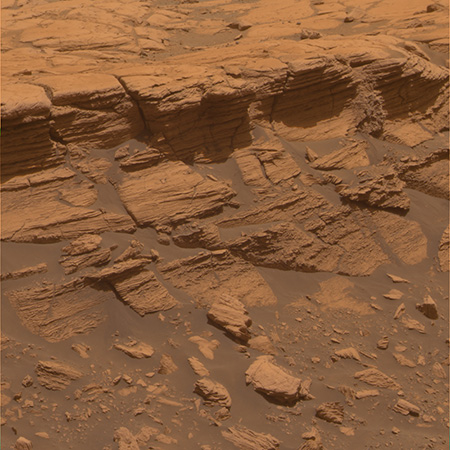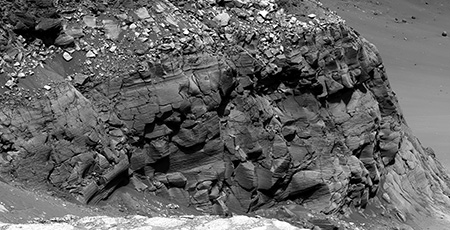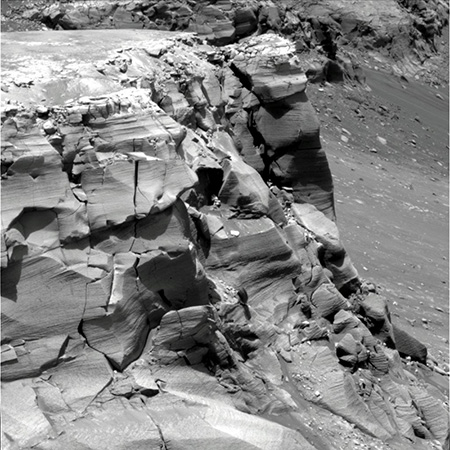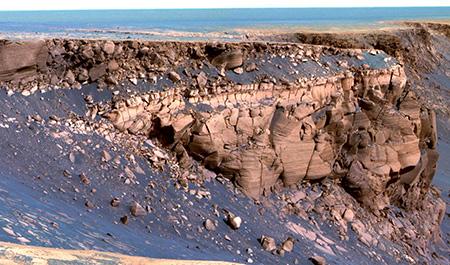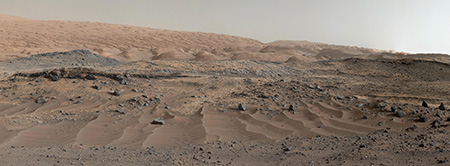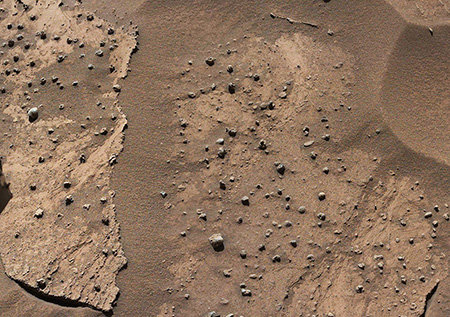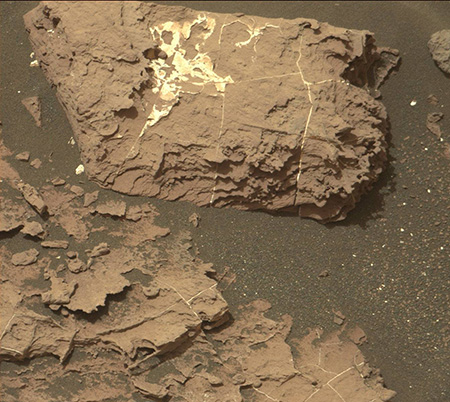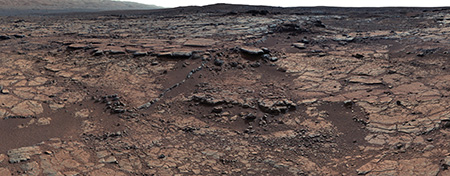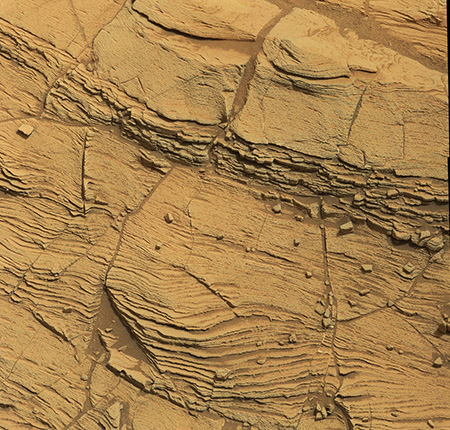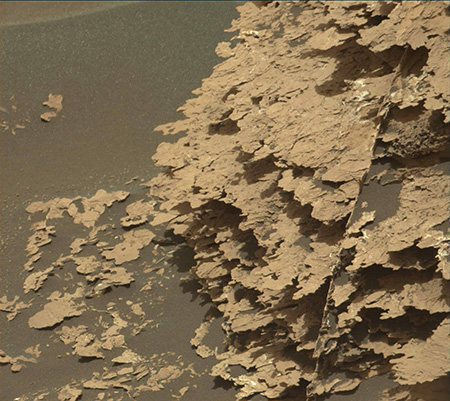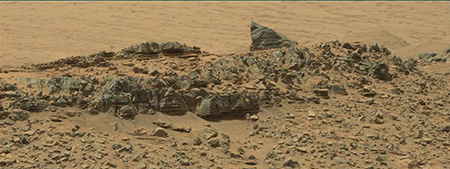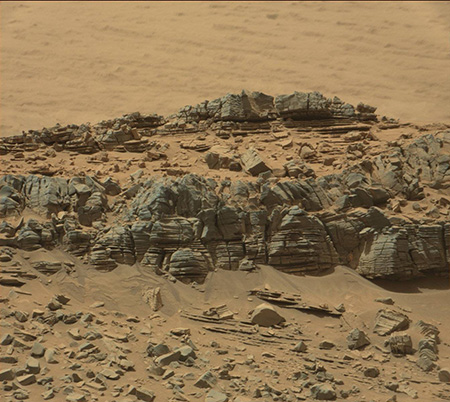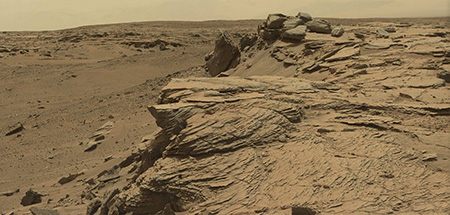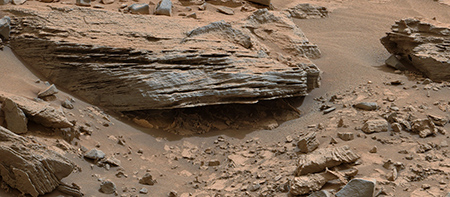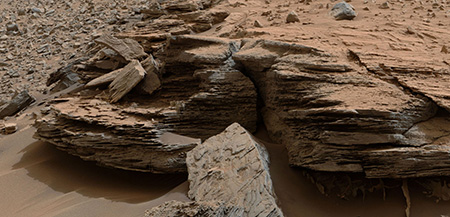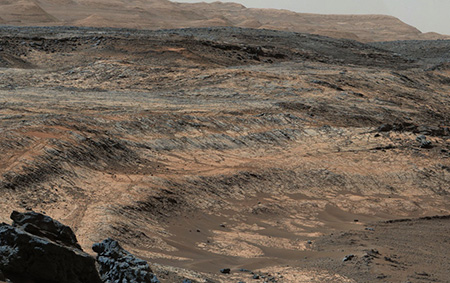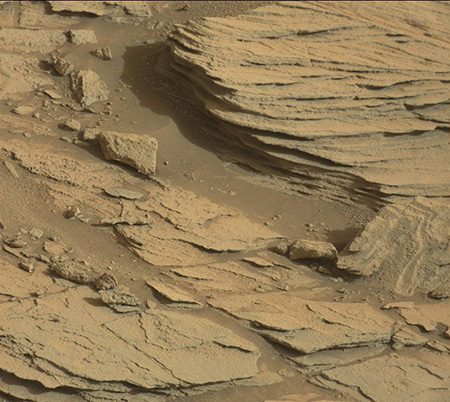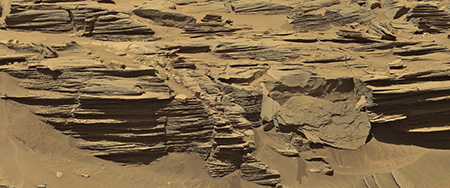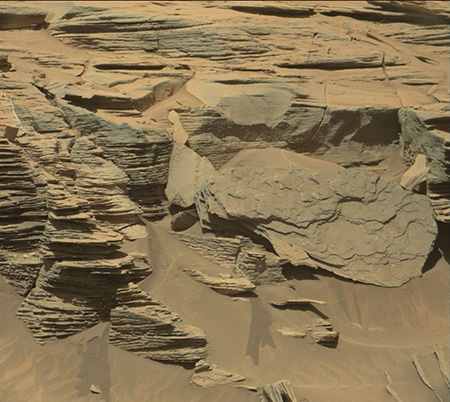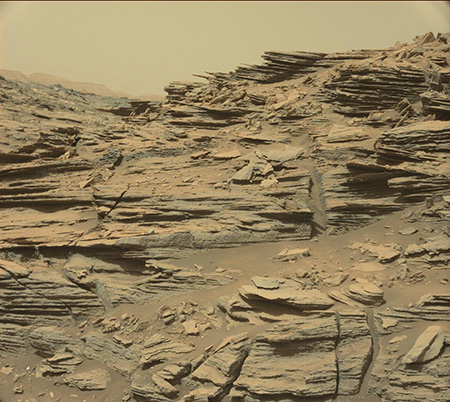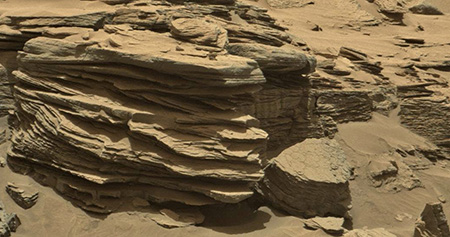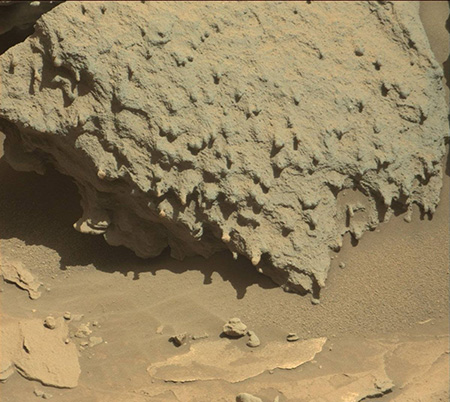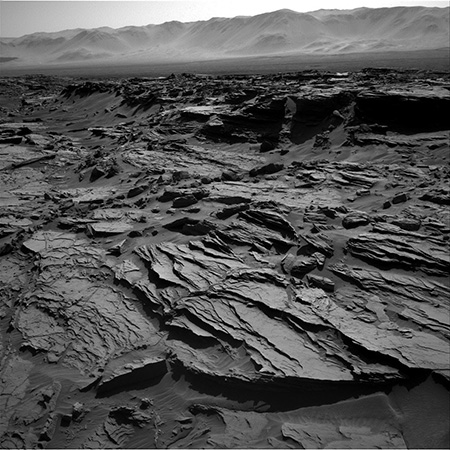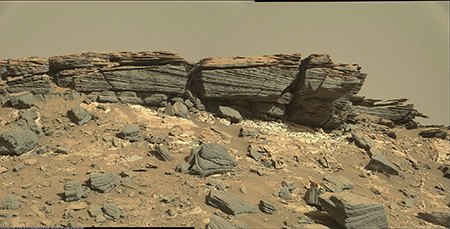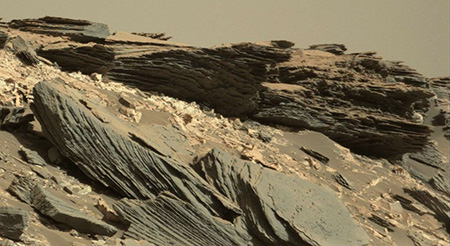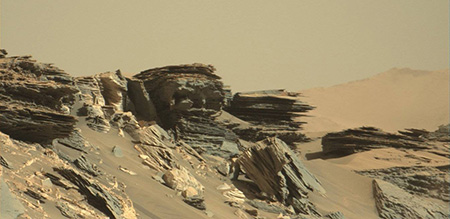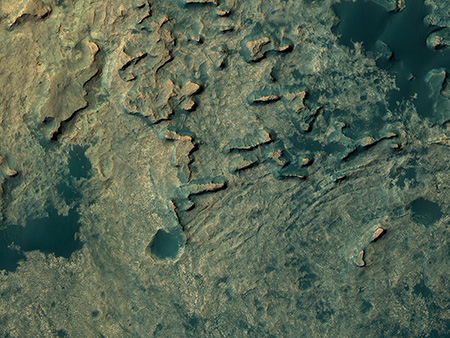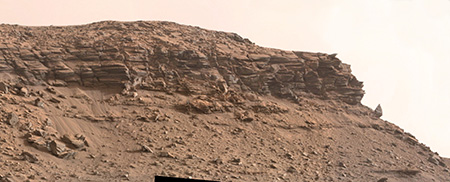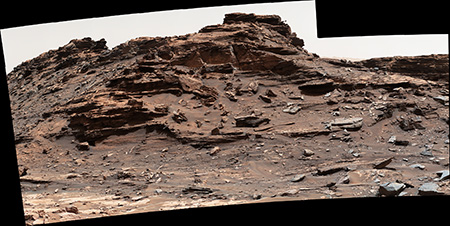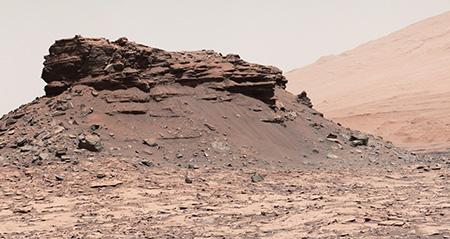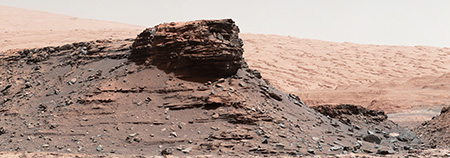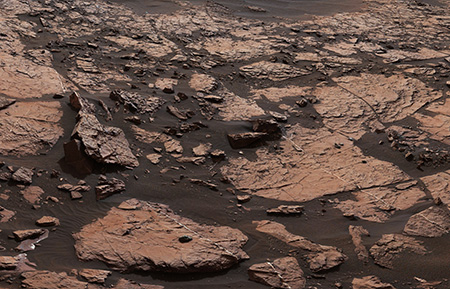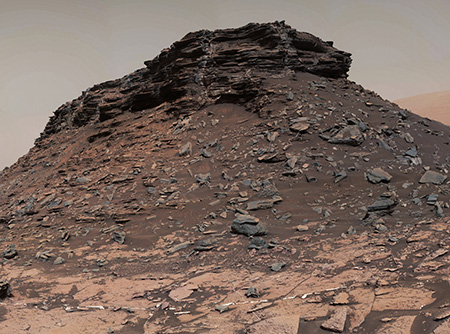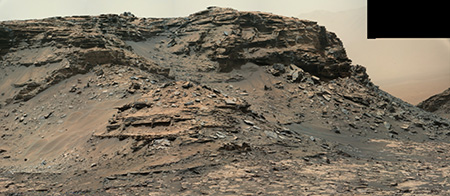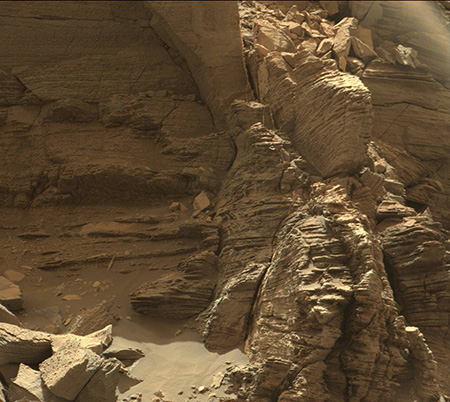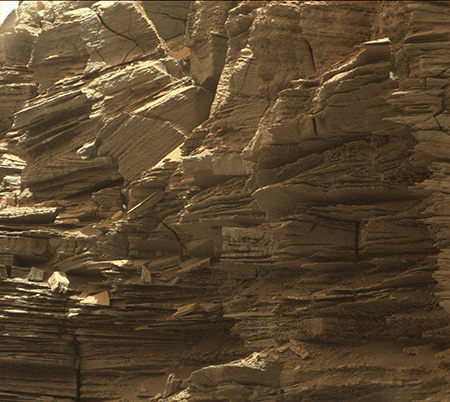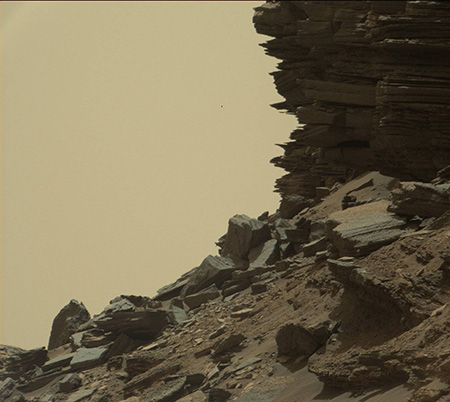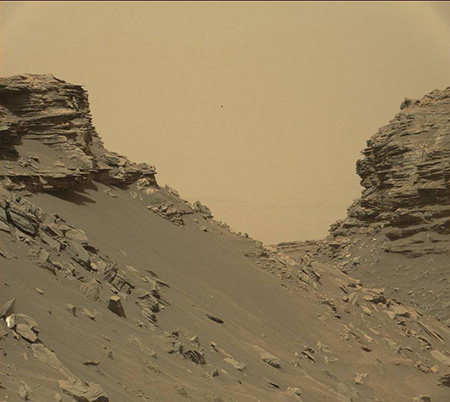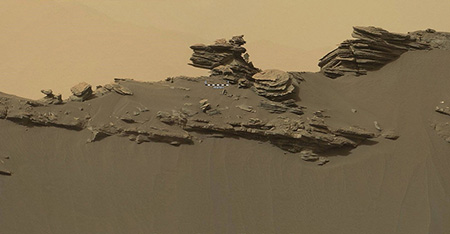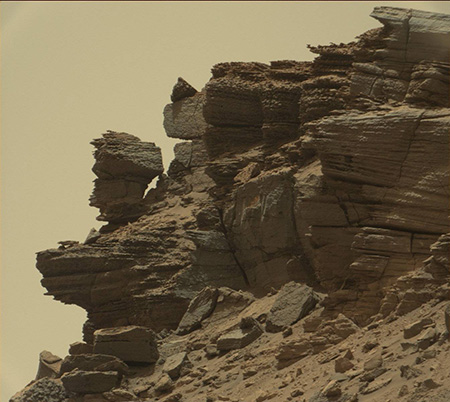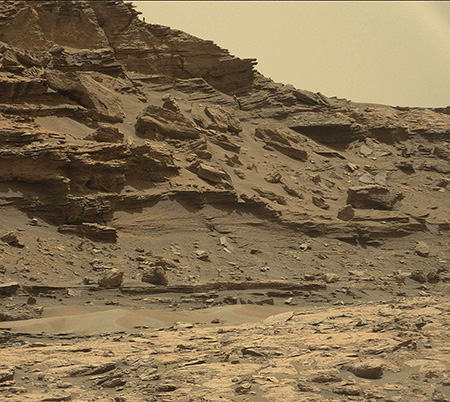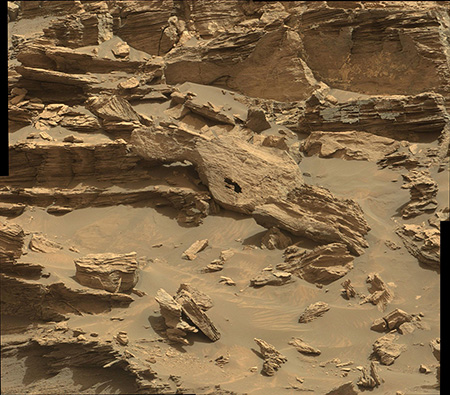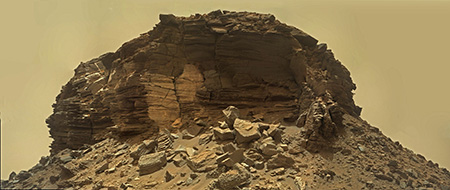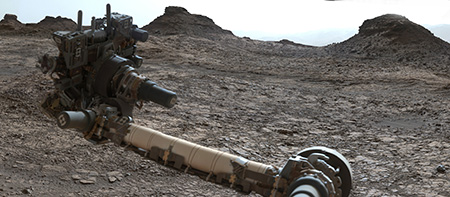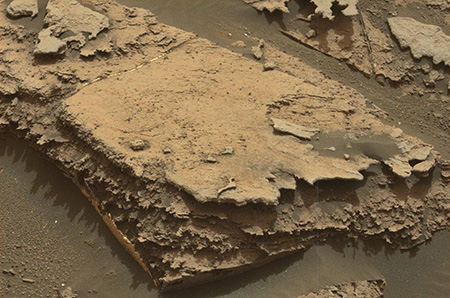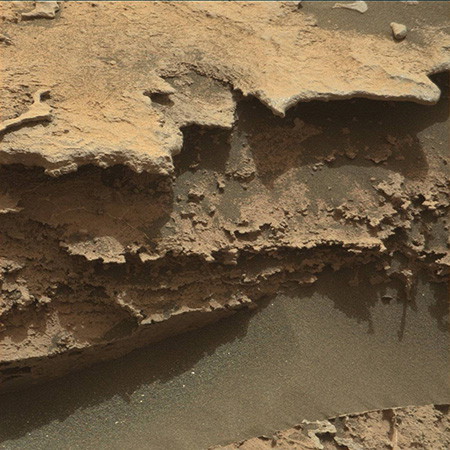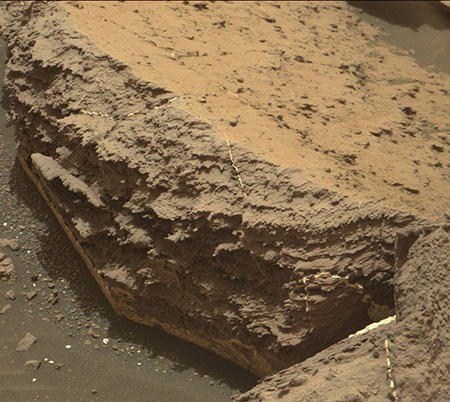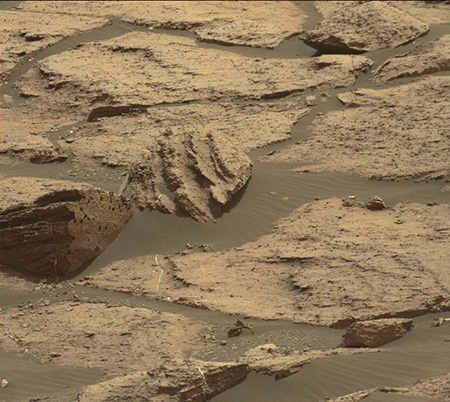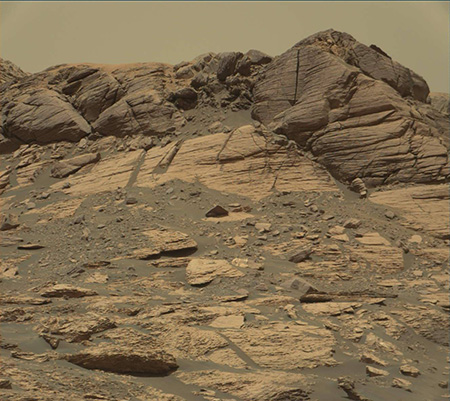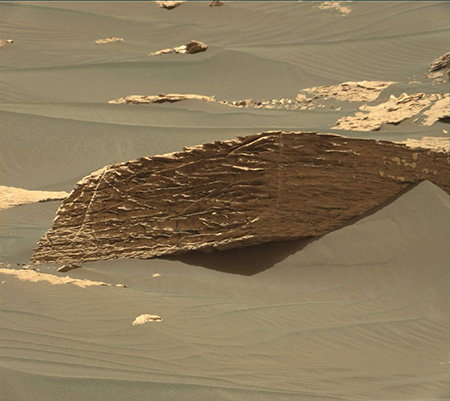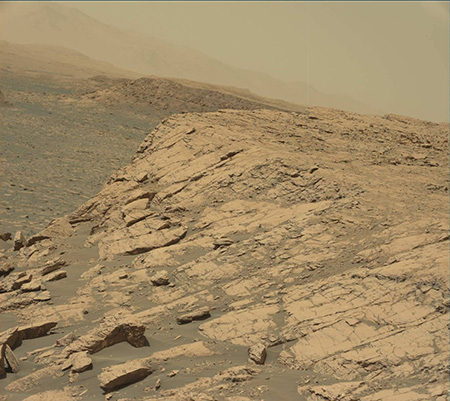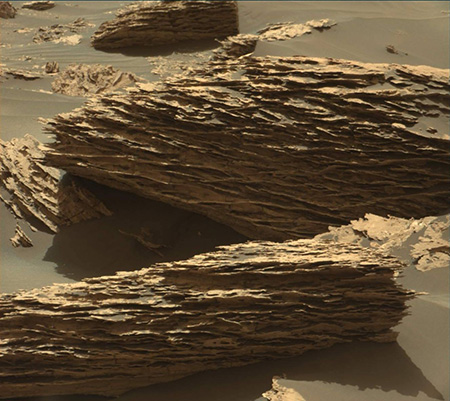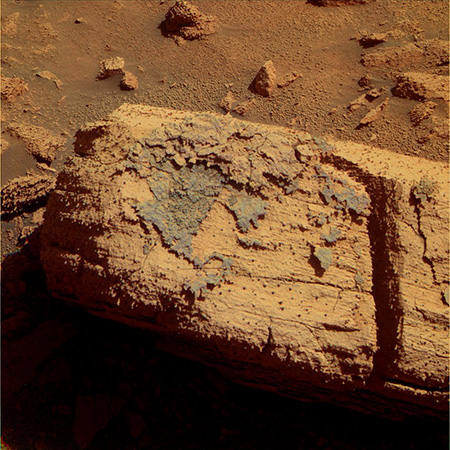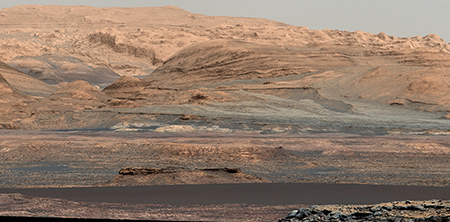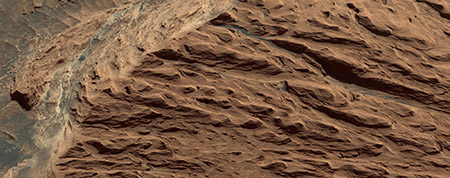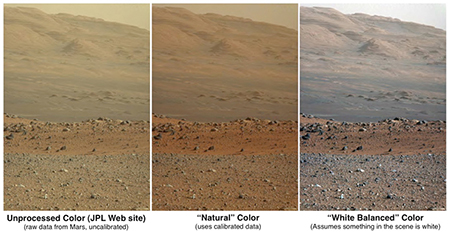edited by Stefanos Folias
A compilation of photos and text on the moqui marbles and sandstone of the Colorado Plateau and analogues on Mars.
Prologue
“Across much of southern Utah, the Jurassic Navajo Sandstone is one of the most porous and permeable formations and easily transmits fluids as a reservoir and an aquifer. Cross–bedding is ubiquitous, and preserves the structure of wind–blown sand that accumulated on the lee (front) side of migrating desert dunes. The Navajo Sandstone host rock is a quartz arenite with weak quartz, carbonate and/or haematite cements, and relatively high porosity, 10–30%.
A remarkable abundance and variety of
haematite concretions are superbly exposed within the Navajo Sandstone.
“Iron oxide as an indicator of fluid flow and occurrences of diagenetic haematite mineralization have been well documented in the Navajo Sandstone. Fluid–flow history can be complicated with multiple generations of alteration, and with many colour combinations that indicate variable geochemical conditions over time.
Near surface, meteoric waters and processes of weathering commonly distribute disseminated iron films that impart a pink to orange–red colour to the sandstone early in the depositional or burial history. The disseminated iron oxides are commonly mobilized and removed by reducing fluids, leaving the sandstone ‘bleached’ to pale, near–white colours.
When these iron–rich fluids mix with oxidizing groundwater, haematite precipitates as a sandstone cement, typically in the form of spherical balls.
“In the Utah concretions, haematite is the major iron oxide, but other metastable iron oxides (for example, goethite–FeOOH) may also be present. As a consequence of the localized cement, concretions are typically more resistant to chemical and mechanical weathering than the host rock and ‘weather out’ to form an apron of loose concretions.”
Above excerpts quoted* from
Marjorie Chan et al.
A possible terrestrial analogue for haematite concretions on Mars.
Nature 429: 731–734, 2004.
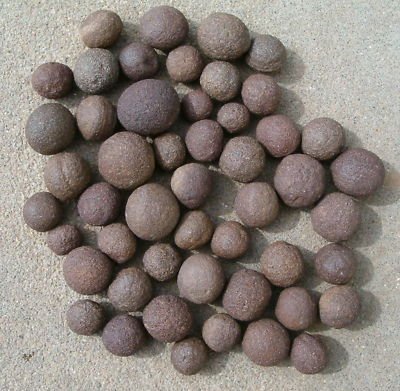
Moqui Marbles/Blueberries
Earth Has ‘Blueberries’ Like Mars
‘Moqui Marbles’ Formed in Groundwater
in Utah’s National Parks
— University of Utah News —
2004
Even before marble–shaped pebbles nicknamed “blueberries” were discovered on Mars by the Opportunity rover, University of Utah geologists studied similar rocks in Utah’s national parks and predicted such stones would be found on the Red Planet.
In a study published in the June 17, 2004 issue of the journal Nature, the Utah researchers suggest both the Martian and Utah rocks—known as hematite concretions—formed underground when minerals precipitated from flowing groundwater.
“We came up with the ‘recipe’ for blueberries,” says Marjorie Chan, chair and professor of geology and geophysics at the University of Utah. “Before Opportunity landed, we thought there might be hematite concretions on Mars. That was based on our study of hematite–rich regions of southern Utah, where hematite balls are found in national parks and have long been a geological oddity that shows up in many rock shops.”
The round rocks are found in southern Utah in Zion and Capitol Reef national parks, Grand Staircase–Escalante National Monument, Snow Canyon State Park and the Moab area.
Their diameters range from one–25th of an inch to 8 inches or more. They are known to New Agers as “moqui marbles.” Some are the size of small blueberries like those on Mars.
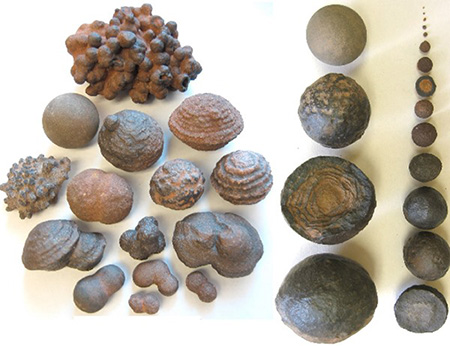
Terrestrial Hematite Concretions/Marbles/Blueberries
photo: Marjorie Chan & Brenda Beitler Bowen
University of Utah
Chan and her colleagues believe the Utah concretions formed perhaps 25 million years ago when minerals precipitated from groundwater flowing through much older Navajo sandstone, the spectacular red rock in southern Utah.
The National Aeronautics and Space Administration’s Opportunity robot rover vehicle landed on Mars’ Meridiani Planum on Jan. 25, 2004. Five days later, it detected hematite within gray pebbles dotting the landing site, and such pebbles later were spotted embedded in a rock outcrop. Cornell University scientist Steve Squyres, who heads the Opportunity science team, said Feb. 9, 2004 the small spheres look “like blueberries in a muffin” and might be concretions.

Eagle Crater, Meridiani Planum, Mars
Opportunity Rover Landing Site
Courtesy NASA/JPL–Caltech/Cornell
In their Nature paper, Chan and colleagues say the Martian “blueberries” may have formed in a similar manner to those in Utah, namely, when significant volumes of groundwater flowed through permeable rock, and chemical reactions triggered minerals to precipitate and start forming a spherical ball.
“Given the similarities between the marbles in Utah and on Mars, additional scientific scrutiny of the Utah concretions and how they form will probably shed further light on the similar phenomenon on Mars,” University of Washington scientist David Catling wrote in a Nature commentary accompanying the University of Utah study.
The concretions may bear on the search for evidence of past life on Mars because bacteria on Earth can make concretions form more quickly. Chan and colleagues plan to analyze whether there is evidence of past microbial activity in Utah concretions.
The study was conducted by Chan and colleagues—graduate student in geology Brenda Beitler Bowen (currently now on the faculty at the University of Utah), and emeritus professor of geology Bill Parry also at the University of Utah; geologist Jens Ormo of the National Institute of Aerospace Technology in Madrid, Spain; and planetary scientist Goro Komatsu of the International Research School of Planetary Sciences at G. d’Annunzio University in Pescara, Italy.
• Martian blueberries and marbles •
The Utah and Mars hematite concretions have similarities and differences.
In Utah and likely on Mars, “you have rocks that had iron in them originally,” says Bowen. “Fluids travel through these rocks and leach out the iron. The water moves through cracks, holes, layers or pores until it reaches some place where the chemistry is different and causes the iron to precipitate out of the water as hematite.”
A major difference is that the Martian “blueberries” probably are pure hematite—a form of iron oxide that is gray because it has a larger crystal structure than the reddish form of iron oxide, commonly known as rust. The Utah concretions are mostly sandstone, cemented by hematite that makes up a few percent to perhaps one–third of the rock. The Martian concretions likely precipitated from acidic groundwater. Those in Utah precipitated when hydrocarbon–rich, briny fluids encountered oxygen–rich groundwater.
After the Utah concretions formed in groundwater, the surrounding Navajo sandstone slowly eroded away over millions of years, so the hard, erosion–resistant concretions accumulated on the ground, often in great numbers.
“The loose Utah concretions roll like marbles into depressions, forming ‘puddles,’ just like their Martian counterparts,” Catling wrote. “The Hopi Indians have a legend that ‘moqui,’ or spirits of their ancestors, played games of marbles with the hematite concretions in the American southwest. Although anthropologists discourage use of the word ‘moqui’ to be respectful to Native Americans, New Age gem collectors sell concretions as ‘moqui marbles’ and claim that they are endowed with metaphysical powers.”
— EAGLE CRATER —
— EREBUS CRATER —

Spherule–rich soil, Payson Outcrop
Erebus Crater, Mars
Courtesy NASA/JPL–Caltech/Cornell
— VICTORIA CRATER —
The cliff in this image is a promontory approximately 12 meters (39 feet) tall on the northern rim of Victoria crater. Layers seen are examples of cross-bedding observed on Mars. Cross-bedding is a geologic term for rock layers which are inclined relative to the horizontal and is indicative of ancient sand dune deposits.The rocks at Victoria Crater once represented a large dune field, not unlike the Sahara desert on Earth, that migrated with an ancient wind flowing from the north to the south across the region. Other rover chemical and mineral measurements have shown that many of the ancient sand dunes studied in Meridiani Planum were modified by surface and subsurface liquid water long ago.
— GALE CRATER —
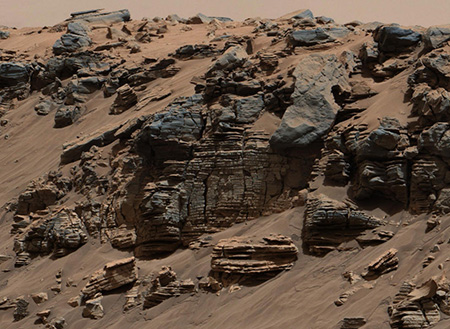
(WHITE BALANCED) Hidden Valley, Mars
A thick-laminated, evenly-stratified rock type forming stratigraphically beneath cross-bedded sandstones regarded as ancient river deposits and interpreted to record sedimentation in a lake, as part of or in front of a delta, where plumes of river sediment settled out of the water column and onto the lake floor.
Courtesy NASA/JPL–Caltech/MSSS
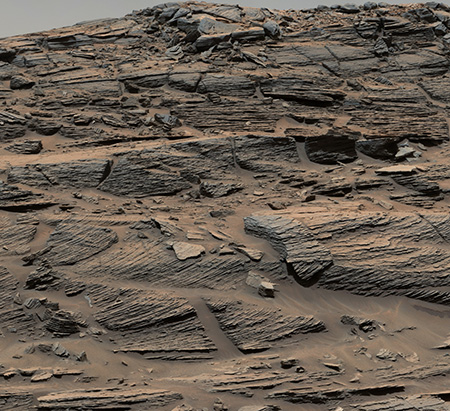
(WHITE BALANCED) Crossbedding, Mount Sharp, Mars
Courtesy NASA/JPL–Caltech/MSSS
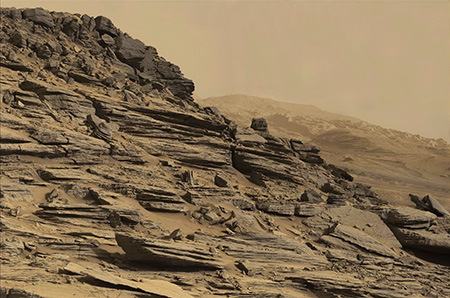
(RAW COLOR) Crossbedding, Mount Sharp, Mars
Courtesy NASA/JPL–Caltech/MSSS/Paul Hammond
— NAUKLUFT PLATEAU —
— MURRAY BUTTES —
— BAR HARBOR —
— VERA RUBIN RIDGE —
• Hematite, water and life •
In 1998, the Mars Global Surveyor orbiting Mars detected what appeared to be a large area of hematite on Meridiani Planum. The broad plain was picked as Opportunity’s landing site because scientists wanted to study the hematite, which almost always forms in water.
Scientists are interested in whether water once existed on Mars (or now exists beneath its surface) because water is necessary for life—and the possibility of life beyond Earth is one of the great questions long pondered by humanity.
“On Earth, whenever we find water, we find life—in surface water or underground water, hot water or cold water—any place there is water on Earth there are microbes, there is life,” says study co–author Bill Parry. “That’s the bottom line: hematite is linked to life.”
While other evidence from Opportunity suggests there once may have been standing water on Meridiani Planum, the Utah team’s study strongly indicates the Martian “blueberries” probably formed in groundwater and not in surface water.
“The ‘blueberries’ easily could have formed in groundwater before there was standing water, if that did exist,” Chan says.
Other scientists previously offered various explanations for Meridiani Planum’s hematite, including that the mineral precipitated in large lakes or in hot springs when Mars’ ancient volcanoes were active, or that hematite was left when water leached away other minerals, or that it formed when volcanic ash deposits were altered chemically.
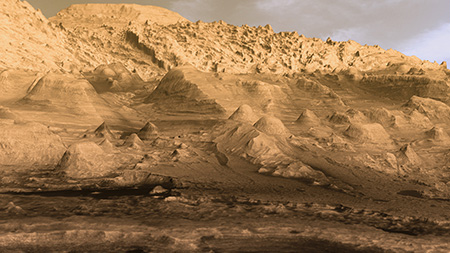
Digital Terrain Model of Mount Sharp, Mars
Courtesy NASA/JPL–Caltech/UA/Kevin M. Gill
• Like Southern Utah, Like Mars •
Chan says her team long suspected concretions like those in Utah might be found on Mars. The idea first was suggested by Ormo and Komatsu in a 2003 scientific abstract that got little if any attention. Ormo contacted Chan in spring 2003 and they started collaborating.
The researchers completed a much broader study published in 2010 indicating that several geological features were seen both in aerial photos of southern Utah’s hematite–rich areas and in images of Mars’ hematite regions taken by orbiting spacecraft. These features include large rocky landforms shaped like knobs, pipes and buttes, and places where bleached–looking rock forms white sediment beds or ring–shapes on the surface.

Knobs & Buttes
Candor Chasma, Valles Marineris, Mars
Courtesy NASA/JPL–Caltech/University of Arizona
The geologists determined the processes responsible for these large–scale features in Utah involved the flow of briny groundwater saturated with natural gas that bleaches sandstone, and that such groundwater flow, the precipitation of hard hematite–cemented rock and the later erosion of surrounding softer rock also would explain the formation of the erosion–resistant pipes, buttes, knobs and concretions. They concluded a similar process could have formed concretions and larger landforms on Mars.
Chan says studying concretions from Utah and Mars “will help us learn more about the history of Mars. When we have something to compare it to, it’s a lot easier to figure out.”
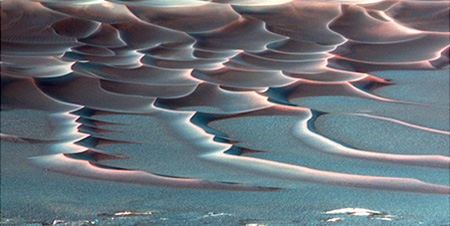
Martian Dust Drifts and Blueberries, Endurance Crater
(FALSE COLOR) Courtesy NASA/JPL–Caltech/Cornell
Acknowledgments: S. Folias would like to thank Marjorie A. Chan for helpful comments and review of this article.
• Articles by M. Chan and Collaborators •
Rainbow of Rocks: Mysteries of Sandstone Colors and Concretions in Colorado Plateau Canyon Country •
Cabbhan & Parry. Public Infomation Series 77, Utah Geological Survey, 2002.
A possible terrestrial analogue for haematite concretions on Mars • Chan et al. Nature 429: 731–734, 2004.
Red rock and red planet diagenesis: Comparisons of Earth and Mars concretions • Chan et al. GSA Today 15:4-10, 2005.
On Earth, as it is on Mars? • Catling.
Nature 429: 707–708, 2004.
Models of iron oxide concretion formation: field, numerical, and laboratory comparisons • Chan et al..
Geofluids 7: 356–368, 2007.
Geomorphic knobs of Candor Chasma, Mars: New Mars Reconnaissance Orbiter data and comparisons to terrestrial analogs • Chan et al. Icarus 205: 138–153, 2010.
Utah's geologic and geomorphic analogs to Mars—An overview for planetary exploration • Chan et al.
GSA Special Papers 483: 349–375, 2011. (link via Google Books)
Characterization of Navajo Sandstone concretions: Mars comparison and
criteria for distinguishing diagenetic origins • Potter, Chan, et al. Earth and Planetary Science Letters 301: 444–456, 2011.
• Color Differences in Photos •
RAW COLOR vs. NATURAL vs. WHITE BALANCED
• Mars Documents and Photos •
Opportunity and Martian Blueberries
Mineral in Mars `Berries' Adds to Water Story
Iron Blueberries
Ancient Lakes on Mars
Signs of Martian Lakebeds on Mars
Mars Rover Nasa Fact Sheet
New Mars Rover (Curiosity) Launched
Mars Globe Image and Mars Facts
HiRISE Imges
A Synthetic Image of the Opportunity Rover on Mars
Curiosity Rover Self–Portrait with Sandstone
Mars Rover Photos Before and After Martian Dust
Color Comparison: Raw vs. Natural vs. White–Balanced
Image Annotated with Distances on Mount Sharp
Mt. Sharp View from Pahrump Hills
Details of Rock Layers in Victoria Crater, Mars
(hi-res) Panorama of Burns Cliff, Endurance Crater
(hi-res) Panorama of Mount Sharp, Gale Crater, Mars
(hi-res) Panorama View from Rocknest, Gale Crater
(hi-res) Topography of Meridiani Planum, Mars
Avalanches on Mars
Rippling Dune Front on Mars
Martian Sunset, Gale Crater
Martian Moon Eclipsing the Sun
Martian Clouds I II
Images from Opportunity
Images from Spirit
Images from Curiosity
Panoramas of Mars (NASA)
Panoramas of Mars (Cornell)
• Spirit Rover Launch Animation •
Spirit Rover 2003–04
• 360° Panoramic Images •
(360° panorama)
(360° panorama)
(360° panorama)
(360° panorama)
*Quoted excerpts reprinted by permission from
Macmillan Publishers Ltd: Nature
Chan, Beitler, Parry, Ormö & Komatsu
A possible terrestrial analogue for haematite concretions on Mars.
Nature 429: 731–734, 2004. © 2004
Earth Has ‘Blueberries’ Like Mars © 2004 University of Utah,
reprinted with permission of the University of Utah,
originally published in the University of Utah News, June 16, 2004.
www.unews.utah.edu
All images included are reprinted with permission from the indicated photographer or
NASA, Jet Propulsion Laboratory-Caltech, Cornell, University of Arizona, MSSS
On Moqui Marbles & Mars Compilation © 2012-2018 Stefanos Folias
